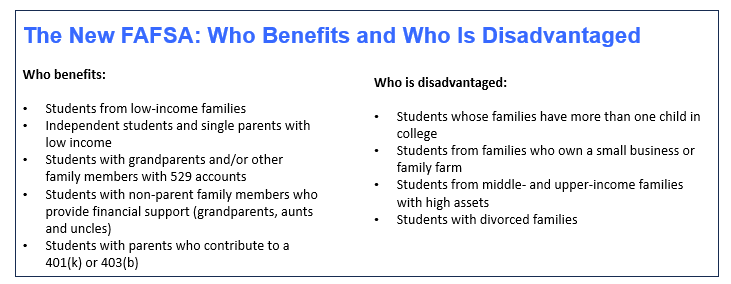In 2021, Congress enacted legislation which directed the Department of Education (DOE) to simplify the Free Application for Federal Student Aid (FAFSA) form. Typically available in October for the coming academic year, the revised and simplified FAFSA will be released in December and will substantially change how financial aid eligibility is calculated. Given the changes detailed below, the delay could create confusion and stress for those families applying for financial aid, whether for a high school senior or a returning college student.
We think it’s important for financial advisors, parents and students to understand the changes and the steps they should take now—and in the future—to enhance their ability to maximize their financial aid eligibility.
Some key highlights and changes to know about the new FASFA:
- The number of questions will be reduced from 108.
- A new eligibility formula and calculation, the Student Aid Index (SAI) will replace the Expected Family Contribution (EFC).
- Cost of Attendance (COA) reported by schools has been redefined, substantially expanded and standardized to reflect true cost.
- The FAFSA Submission Summary replaces the Student Aid Report.
- Automatic transfer of IRS tax returns from IRS directly to the FAFSA.
Some of the most impactful changes
In addition to fewer questions, there are numerous substantiative changes in the 2024/25 FAFSA and the underlying methodology used to determine financial aid eligibility. The following are some of the most impactful and significant changes made to the new FAFSA. Understanding these changes and how they will impact current and future student financial aid is important for college planning and funding.
- 529 college savings plan assets in grandparents’ or other family members’ accounts will no longer be reported on the FAFSA and therefore, 529 assets will have no impact on financial aid calculations.
- Several sources of untaxed income will no longer be reported as income, such as veterans’ benefits, workers’ compensation and cash child support by a divorced parent as well as contributions to 401(k)s and 403(b)s. (Note: SIMPLE and SEP contributions will continue to be assessed as income.)
- Less aid for multiple children in college. The number of children in college will no longer be reported; therefore, the parental contribution of the SAI (formerly EFC) will no longer be divided by the number of children enrolled in college.
- For students with divorced and separated parents, the parent responsible for providing information on the FAFSA will be the parent providing more financial support to the student, instead of the parent with whom the student resides most of the time.
- For small business owners and for families that reside on a family farm, their “asset exclusions” have been eliminated. Going forward, they must report their assets on the FAFSA.
- Cost of Attendance (COA) has been redefined and substantially expanded to include an accurate COA. It will now include tuition and fees, housing and meals (previously called room and board), books and other course materials, transportation, personal expenses, loan fees and costs associated with obtaining professional licensure, certification or credentials.
The table below indicates how the change in methodology will benefit some students (increase financial aid) and disadvantage others (decrease financial aid).
 It is important to emphasize that students from high-net-worth families can benefit from filing a FAFSA. There are many types of student aid programs available from federal and state governments and from colleges, including loans, grants and merit awards which require the filing of the FAFSA. For example, all students regardless of income are eligible for a Direct Student Loan. Most colleges require a student to submit a FAFSA before they award institutional aid including grants, loans, and merit awards.
It is important to emphasize that students from high-net-worth families can benefit from filing a FAFSA. There are many types of student aid programs available from federal and state governments and from colleges, including loans, grants and merit awards which require the filing of the FAFSA. For example, all students regardless of income are eligible for a Direct Student Loan. Most colleges require a student to submit a FAFSA before they award institutional aid including grants, loans, and merit awards.
With the December launch delay and since institutional aid is on a first-come, first-serve basis, a student can increase their chances of maximizing financial aid awards by filing as early as possible. An additional benefit in filing early is that a student will have more time to negotiate and appeal a college’s financial aid decision and thus be able to compare college aid packages before the college’s decision deadline for matriculation.
Finally, we would emphasize that understanding how the timing of family finances impacts potential financial aid is key to sound college planning. Financial information required on the FAFSA is based on the “prior-prior” tax year (referred to as the base year). For example, the 2024–2025 FAFSA—and thus financial aid awards—will be based on income information from the 2022 tax return. Although it’s too late to change one’s 2022 tax returns, families should understand how these changes will impact them this coming year if they have a student currently in college and in the future. We recommend taking proactive financial and tax planning steps now to maximize their financial aid eligibility in the future.
Don’t wait for the FAFSA release. Steps to take now:
-
- Go to Studentaid.gov here and create an FSA ID for the student and filing parent. Both will need an FSA ID to complete the FAFSA.
- Identify the parent(s) who will provide financial information and tax returns.
- Make sure tax forms for 2022 have been filed with the IRS for both the student and parent as 2020 tax return information is required to complete the FAFSA.
- Know college and state FAFSA filing deadlines, as some are as early as January 15, 2024. If you miss the college’s deadline, you will not qualify for financial aid.
- In advance of the December FAFSA release, and after, parents and high school students can use the free SAI estimator at Franklintempleton.com to get an approximate indication of how much need-based financial aid they may qualify for and therefore how much they will have to pay to attend a particular college. This can be a critical step in deciding which colleges to apply to as awards will vary from college to college.
Unless otherwise noted, the views, comments, and analysis are those of the author, may change without notice, and are not updated to reflect subsequent developments. They do not necessarily represent the views of Franklin Templeton Investments. Franklin Templeton Investments is not affiliated with Invite Education or Strategic Advancement Group , and they are not authorized to make representations or commitments for Franklin Templeton. While this information is being made available through Franklin Distributors, Inc (“FD”), such access does not constitute an endorsement or recommendation of the content contained herein by FD. FD does not independently verify or make any representation as to the accuracy or completeness of information. Laws and regulations are complex and subject to change. Franklin Templeton makes no warranties with regard to this information or results obtained by its use; and disclaims any liability arising out of the use of, or any tax position taken in reliance on, such information. Prior results do not guarantee a similar outcome.
WHAT ARE THE RISKS?
Any information, statement or opinion set forth herein is general in nature, is not directed to or based on the financial situation or needs of any particular investor, and does not constitute, and should not be construed as, investment advice, forecast of future events, a guarantee of future results, or a recommendation with respect to any particular security or investment strategy or type of retirement account. Investors seeking financial advice regarding the appropriateness of investing in any securities or investment strategies should consult their financial professional.
IMPORTANT LEGAL INFORMATION
This material is intended to be of general interest only and should not be construed as individual investment advice or a recommendation or solicitation to buy, sell or hold any security or to adopt any investment strategy. It does not constitute legal or tax advice. This material may not be reproduced, distributed or published without prior written permission from Franklin Templeton.
The views expressed are those of the investment manager and the comments, opinions and analyses are rendered as at publication date and may change without notice. The underlying assumptions and these views are subject to change based on market and other conditions and may differ from other portfolio managers or of the firm as a whole. The information provided in this material is not intended as a complete analysis of every material fact regarding any country, region or market. There is no assurance that any prediction, projection or forecast on the economy, stock market, bond market or the economic trends of the markets will be realized. The value of investments and the income from them can go down as well as up and you may not get back the full amount that you invested. Past performance is not necessarily indicative nor a guarantee of future performance. All investments involve risks, including possible loss of principal.
Any research and analysis contained in this material has been procured by Franklin Templeton for its own purposes and may be acted upon in that connection and, as such, is provided to you incidentally. Data from third party sources may have been used in the preparation of this material and Franklin Templeton (“FT”) has not independently verified, validated or audited such data. Although information has been obtained from sources that Franklin Templeton believes to be reliable, no guarantee can be given as to its accuracy and such information may be incomplete or condensed and may be subject to change at any time without notice. The mention of any individual securities should neither constitute nor be construed as a recommendation to purchase, hold or sell any securities, and the information provided regarding such individual securities (if any) is not a sufficient basis upon which to make an investment decision. FT accepts no liability whatsoever for any loss arising from use of this information and reliance upon the comments, opinions and analyses in the material is at the sole discretion of the user.
Products, services and information may not be available in all jurisdictions and are offered outside the U.S. by other FT affiliates and/or their distributors as local laws and regulation permits. Please consult your own financial professional or Franklin Templeton institutional contact for further information on availability of products and services in your jurisdiction.
Issued in the U.S. by Franklin Distributors, LLC, One Franklin Parkway, San Mateo, California 94403-1906, (800) DIAL BEN/342-5236, franklintempleton.com – Franklin Distributors, LLC, member FINRA/SIPC, is the principal distributor of Franklin Templeton U.S. registered products, which are not FDIC insured; may lose value; and are not bank guaranteed and are available only in jurisdictions where an offer or solicitation of such products is permitted under applicable laws and regulation.
Please visit www.franklinresources.com to be directed to your local Franklin Templeton website.

